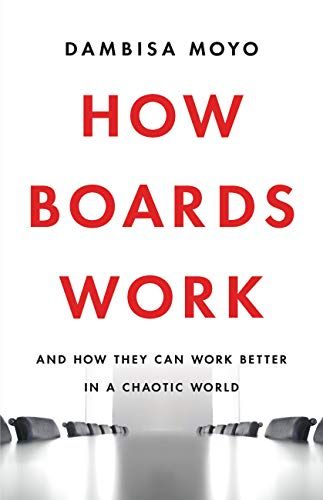Influential economist and best-selling author Dambisa Moyo offers a detailed overview of the hows and whys of corporate boards, with a special emphasis on their social and envrionmental responsibilities.

A Primer on Boards
Time’s “100 Most Influential People in the World,” Thinkers50 shortlister, and New York Times best-selling author Dambisa Moyo provides detailed insight into the core and evolving responsibilities of corporate boards. Moyo clarifies how boards’ roles and responsibilities have changed with the rise of environmental, social and governance (ESG) concerns, and goes on to advocate for more diverse, savvy and assertive boards that guide firms for the benefit of all stakeholders.
Moyo connects the board’s functions to organizational success on almost every page; she makes clear how boards define a corporation’s culture, morals and strategic aims.
Provide Guidance and Accountability
Moyo outlines the essential purpose of boards – to guide executives and hold them accountable – and discusses the processes by which boards address strategy, approach leader recruitment and succession, and oversee the organization’s ethics, values and culture. Most boards consist of about 12 members, Moyo says, who establish four committees: a nominations and governance committee, an audit committee, a compensation committee and a corporate social responsibility committee.
The essential difference between a board and a CEO is that the board is fundamentally a structure of governance, while the CEO is a day-to-day leader.Dambisa Moyo
Moyo explains the board members’ roles, beginning with the most basic facts, such as that a chairperson heads every board and that senior executives, including the CEO, report to the board. Moyo goes on to explain customary practices, such as that in the United States, the CEO usually serves as board chair, whereas elsewhere the CEO might sit on the board, but another director chairs it. And she covers board members’ responsibilities and risks, including that board members must rely on information the firm’s executives provide and that directors can risk loss of reputation, lawsuits and even potential financial ruin.
Oversee Strategy, Foresee Disruption
Moyo explains that most boards meet for two or three days annually to examine and debate management’s strategic plans for the coming year and outline goals for the next three to five years. Boards should never rubber-stamp strategic plans, she says, and investors, both passive and active, often influence their decisions.
Massive technological disruption and new, fundamental resets springing from technologies such as artificial intelligence, blockchain and cyber warfare mean boards and firms can never afford to be passive, Moyo points out. They must anticipate the effects of future changes in the business environment. In coming years, Moyo says, pressures will include low returns and growing talent gaps. Shortages will drive competition for the best talent, and wages will increase. Competition for customers has gone global, she notes.
Seek Diversity
In discussing the makeup of boards, Moyo explains that board members must understand the business well enough to apply their deep and narrow expertise insightfully, and that boards should seek highly qualified, diverse candidates. Good boards adapt, Moyo says; to do so, they seek a balance of skills, experience, knowledge and age among members. She covers the reasons why ex-CEOs dominate most boards and the fact that boards also need specialized knowledge – financial, geopolitical, engineering, regulatory or industry-related. In Germany, she points out, employees must occupy almost half the seats on corporate boards; the United States has yet to enact similar legislation.
While management operates the company on a day-to-day basis, it is the board’s responsibility to look on from 40,000 feet. Dambisa Moyo
Organizations with racially diverse boards outperform those without diverse boards, Moyo says. She describes the current state of racial and gender equity in boards; in the United Kingdom, for example, minorities hold only about 8% of FTSE 100 board seats. Gender equity continues to elude boards: Despite decades of gains, women still hold only two dozen Fortune 500 board seats. Boards must insist on progress in diversity, equity and inclusion (DEI) by tying executive compensation to DEI goals, Moyo urges.
Double-Check Forecasts and Plans
With regard to boards’ roles in guiding an organization, Moyo explains that the board should double-check the organization’s financial forecasts and skills requirements, as well as the performance goals of the firm’s strategy. The board should examine plans with an eye to ethics, internal operations and supply lines, she says.
CEO succession – the hiring (and firing, when it is warranted) of the company chief executive – is one of the key responsibilities of the board.Dambisa Moyo
The board, Moyo says, should ensure the company executes its chosen strategies. Boards deal with daily tactical urgencies that can impede the implementation of strategies, as well as resistance from business units intent on protecting legacy products from new strategic directions. When a crisis hits, the board should spring into action.
Ensure Leadership
Finding the right CEO can take years, Moyo points out, and the best boards address the issue at every meeting. They seek successors even as a new CEO joins the firm. A leader who breaches a company’s values or ethics betrays trust, and the board must unite to remove the offender.
Boards should conduct formal performance evaluations of each board member at least annually, Moyo says. Free riders or those who breach duty-of-care or loyalty commitments must go. High-performing members should not have to leave due to arbitrary age limits.
Uphold Values and Social Responsibility
To avoid future failures – including financial crises – board members must stay well-informed, keep up with technology, hold themselves accountable to excellence and stand up to those who would sacrifice the firm’s long-term interests for the sake of short-term gains, Moyo says.
For context, Moyo reviews some of the history regarding views of the role of corporations in society. Nobel Prize–winning economist Milton Friedman argued that businesses exist only to make profits and to serve shareholders, she explains. If they pursue those goals, he advised, they serve the larger social good.
Virtually every board, in every company, in every industry, is contending with sometimes conflicting demands for environmental and social change with urgency.Dambisa Moyo
This view holds sway no longer, Moyo points out: In 2019, 181 CEOs of the Business Roundtable signed an agreement committing their firms to serve all stakeholders – customers, employees, vendors, communities and investors. Board members must embrace and support these new values, Moyo says.
Companies that allow disconnects between stated values and observed behavior or decisions can lose customers and find it difficult to attract top talent, Moyo notes. Boards drive change by helping the culture adapt, she says. They hold firms accountable regarding DEI, pay equity, environmental impact and working conditions.
A Universal Guidebook
At first glance, Moyo’s overview of boards might appear fit only for high school or business students. A closer look reveals that Moyo writes for anyone who works in a publicly held company, up to and including executives. This detailed but concise guide would benefit the many employees who have no idea how their company board functions or even why boards exist.
Dambisa Moyo is a Zambian-born economist known for her analyses of macroeconomics and global affairs. She is a member of the House of Lords of the United Kingdom. She is the author of the best-selling books Dead Aid, How the West Was Lost, Winner Take All, and The Edge of Chaos.





